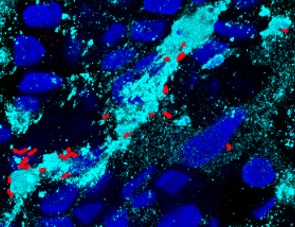Cystic fibrosis: preventing bacteria from docking to the airways
Cystic fibrosis is a genetic disease that causes severe respiratory complications. Despite many therapeutic advances, chronic bacterial infection remains the leading cause of death in people with cystic fibrosis.
Understanding what facilitates bacterial infections...
A few years ago, researchers from Prof. Marc Chanson's laboratorydemonstrated the key role played by the Vav3 protein in this process. Vav3 drives the formation of real docking terminals on the surface of the respiratory airways that facilitate bacterial infections (as seen in the figure below).

Adhesion of bacteria (in red) to docking terminals (in cyan) formed on the surface of respiratory cells with cystic fibrosis (in blue). © Prof. Chanson's laboratory - UNIGE
Inspired by this discovery, the scientists set out to understand the underlying molecular mechanisms. In collaboration with two other teams from the Faculty of Medicine, they found the responsible molecule: the HuR protein. They observed, not only with cell lines but also with cells from patients, that in cystic fibrosis, the HuR protein is over-expressed. This overabundance stabilises the RNA code responsible for the production of Vav3, causes its accumulation and consequently the formation of docking stations for the bacteria.
… to fight them better
To confirm their discovery, they inhibited the HuR protein in cystic fibrosis cells in several different ways. Inhibition of HuR, including through two pharmacological inhibitors, prevented the formation of docking terminals and limited bacterial adhesion, without causing cell toxicity or inflammation. Although further investigations are still needed, this study opens up new possibilities for preventing respiratory infections in people with cystic fibrosis.
19 Jan 2023
